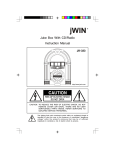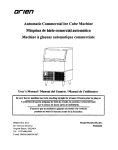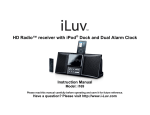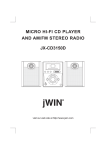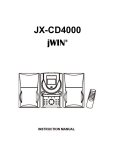Download Jwin jk-3030 User's Manual
Transcript
5.5" B/W Television with 7 Channel Weather Band and AM/FM Stereo Radio Instruction Manual JK-3030 http://www.jwin.com CAUTION: TO REDUCE THE RISK OF ELECTRIC SHOCK, DO NOT REMOVE COVER (OR BACK). NO USER SERVICEABLE PARTS INSIDE. REFER SERVICING TO QUALIFIED SERVICE PERSONNEL. The lighting flash with arrowhead symbol within an equilateral triangle is intended to alert the user to the presence of uninsulated dangerous voltage within the products's enclosure that may be of sufficient magnitude to constitute a risk of electric shock to persons. The exclamation point within an equilateral triangle is intended to alert the user to the presence of important operating and maintenance (servicing) instructions in the literature accompanying the appliance. WARNING: TO REDUCE THE RISK OF FIRE OR ELECTRIC SHOCK. DO NOT EXPOSE THIS APPLIANCE TO RAIN OR MOISTURE. PORTABLE CART WARNING DO NOT REMOVE THIS TAG (MARKING) The words WARNING. MOVE WITH CARE. THIS CART/APPLIANCE COMBINATION SHOULD NOT BE MOVED BY CHILDREN WITHOUT PROPER GUIDANCE FROM AN ADULT OR An appliance and cart combination should be moved with care. Quick stops, excessive force, and uneven surfaces may cause the appliance and cart combination to overturn. IMPORTANT SAFETY INSTRUCTIONS CAUTION Electrical energy can perform many useful functions. This unit has been engineered and manufactured to assure your personal safety. Improper use can result in potential electrical shock or fire hazards. In order not to defeat the safeguards, observe the following basic rules for its installation, use and servicing. 1. Read Instructions All the safety and operating instructions should be read before the appliance is operated. 2. Retain Instructions The safety and operating instructions should be retained for future reference. 3. Heed Warnings All warnings on the appliance and in the operating instructions should be adhered to. 4. Follow Instructions All operating and use instructions should be followed. 5. Water and Moisture The appliance should not be used near water for example, near a bathtub, washbowl, kitchen sink, laundry tub, in a wet basement, or near a swimming pool, and the like. 6. Carts and Stands The appliance should be used only with a cart or stand that is recomended by the manufacturer. 1 6A. An appliance and cart combination should be moved with care. Quick stops, excessive force, and uneven surfaces may cause the appliance and cart combination to overturn. 7. Wall or Ceiling Mounting The appliance should be mounted to a wall or ceiling only as recommended by the manufacturer. 8. Ventilation The appliance should be situated so that its location or position does not interfere with its proper ventilation. For example, the appliance should not be situated on a bed, sofa, rug, or similar surface that may block the ventilation openings or placed in a built-in installation, such as a bookcase or cabinet that may impede the flow of air through the ventilation openings. 9. Heat The appliance should be situated away from heat sources such as radiators, heat registers, stoves, or other appliances (including amplifiers) that produce heat. 10. Power Sources The appliance should be connected to a power supply of the type described in the operating instructions or as marked on the appliance. 11. Grounding or Polarization Observe the precautions that should be taken so that the grounding or polarization protective features of an appliance are not defeated. 12. Power Cord Protection Power supply cords should be routed so that they are not likely to be walked on or pinched by items placed upon or against them, paying particular attention to cords at plugs, convenience receptacles, and the point where they exit from the appliance. 13A. Cleaning The appliance should be cleaned only as recommended by the manufacturer. 13B. Do not use liquid cleaners or aerosol cleaners. Use a damp cloth for cleaning. 14. Power Lines An outdoor antenna should be located away from power lines. 15. Outdoor Antenna Grounding If an outside antenna is connected to the receiver, be sure the antenna system is grounded so as to provide some protection against voltage surges and built up static charges. Section 801 of the National Electrical Code. ANSI/NFPA NO. 70-1984, provides information with respect to proper grounding of the mast and supporting structure, grounding of the lead-in wire to an antenna discharge unit, size of grounding electrodes, and requirements for the grounding electrode. See Figure 73.1. 16. Nonuse Periods The power cord of the appliance should be unplugged from the outlet when left unused for a long period of time. 2 17. Object and Liquid Entry Care should be taken so that objects do not fall and liquids are not spilled into the unit through openings. 18. Damage Requiring Service The appliance should be serviced by qualified service personnel when: A. The power supply cord or the plug has been damaged; or B. Objects have fallen, or liquid has been spilled into the appliance; or C. The appliance has been exposed to rain; or D. The appliance does not appear to operate normally or exhibits a marked change in performance; or E. The appliance has been dropped, or damaged. 19. Servicing The user should not attempt to service the appliance beyond instructions given in the operating instructions. All other servicing should be referred to qualified service personnel. POWER LINES SERVICE ENTRANCE CONDUCTORS GROUND CLAMPS STANDOFF INSULATORS b MAST SERVICE ENTRANCE EQUIPMENT ANTENNA LEAD IN WIRE GROUND WIRE GROUND CLAMPS ANTENNA DISCHARGE UNIT c TO EXTERNAL ANTENNA TERMINALS OF PRODUCT GROUND WIRE a. a GROUND CLAMPS a. a POWER SERVICE GROUNDING ELECTRODE SYSTEM (e.g. ntenor water pipe) BONDING JUMPER OPTIONAL ANTENNA GROUNDING ELECTRODE DRI/ENG FEET (2.44 m) INTO THE EARTH IF REQUIRED BY LOCAL CODES SEE NEC SECTION 810-21 (1) c FIGURE 73.1 EXAMPLE OF ANTENNA GROUNDING AS PER NATIONAL ELECTRICAL CODE INSTRUCTIONS CONTAINED IN ARTICLE 810RADIO AND TELEVISION EQUIPMENT a. Use No. 10 AWG (5.3 mm2) copper, No. 8 AWG (8.4 mm2) aluminium, No. 17 AWG (1.0 mm2) copper-clad steel or bronze wire, or larger, as a ground wire. b. Secure antenna lead-in and ground wire to house with stand-off insulators spaced from 4 - 6 feet (1.22 - 1.83 m) apart. c. Mount antenna discharge unit as close as possible to where lead-in enters house. d. Use jumper wire not smaller than No. 6 AWG (13.3 m 2) copper, or the equivalent when a separate antenna-grounding electrode is used. See NEC Section 810 - 21 (i). 3 3 4 5 2 13 11 1 6 7 8 12 14 9 10 19 1. 2. 3. 4. 5. 6. 7. 8. 9. 10. HEADPHONE JACK POWER INDICATOR TV MONITOR FUNCTION SELECTOR DIAL SCALE VOLUME CONTROL BAND SELECTOR FM STEREO INDICATOR TUNING KNOB POWER KNOB BUTTON 16 17 18 15 11. 12. 13. 14. 15. 16. 17. 18. 19. SPEAKER GRILL DC 12V JACK TELESCOPIC ANTENNA EXTERNAL TV ANTENNA JACK BATTERY DOOR VERTICAL V-HOLD BRIGHTNESS CONTRAST WEATHER CHANNEL BAND SELECTOR POWER SUPPLY AND CONNECTION Battery Operation Remove Battery Compartment Cover. Put in 10 batteries (UM-2 or equivalent) in correct polarity as indicated inside the compartment. Replace the cover. Note: Check your batteries regularly, old or discharged batteries should be replaced. If the unit is not going to be used for some time or is being run exclusively on alternative power, remove the batteries to avoid leakage and damage. High power batteries only should be used to operate this unit AC Mains Power Operation Take the supplied AC adaptor cord and connect the corresponding end to the DC Socket and household mains power outlet. Make sure the voltage is compatible. Note: If you plug the AC adaptor cord off from the AC Socket and from the unit, the unit will operate with battery power. 4 RADIO OPERATION Press the Power Switch down to turn on the unit and the Power indicator light up. Set Function Selector to RADIO position. Select the desired radio frequency band with Band Selector. For FM Stereo, FM Stereo LED light on. Rotate Tuning Control to set the Dial Pointer against the station frequency as marked on the dial scale. Adjust Volume Control to the desired volume level. ANTENNA For FM stations, extend the Telescopic Antenna to full length, adjust the angle and direction for the best reception. However, medium wave signals are picked up through the built-in ferrite antenna. You may have to orient the set to obtain the clearest reception. TV OPERATION Press the Power Switch down to turn on the unit. Set Function Selector to TV position. Select the desired TV frequency band with Band Selector. Rotate Tuning Control to set the Dial Pointer against the station frequency as marked on the dial scale. Adjust Volume Control to the desired level. Adjust V-HOLD, BRIGHTNESS and CONTRAST on back to the desired level. EXTERNAL ANTENNA If desired you may hook up an outdoor antenna to your portable TV set, which will give you greater range and clearer reception for the channels which are difficult to receive with the built-in antenna. To hook up the outdoor antenna, just connect the VHF or UHF antenna to the Antenna Adaptor (included in your set), and then connect the Antenna Adaptor to the External Antenna Jack. Note: When the antenna adapter is plugged into the external antenna jack, the telescopic antenna is automatically disconnected. WEATHER BAND AND ALERT OPERATION Set Function Selector to WB position. Select the appropriate Weather Band frequency with Weather Channel Band Selector for the best reception. Adjust Volume Control to the desired level. Set Function Selector to ALERT position in standby stage for ALERT operation. Pre-set WB channel will switch on to alert emergency weather with Beep sound. PRIVATE LISTENING (EARPHONE) An earphone jack is provided for your private listening enjoyment when the earphone plug is inserted into the jack. The internal speaker is automatically disconnected. Note: The jack is designed to permit the use of 3.5mm plug earphone only. 5 SPECIFICATION Power Supply: DC 12V Radio Frequency Coverage: AM 530 - 1710 KHz FM 88 - 108 MHz Weather Band Frequency Coverage: CH 1 162.550 MHz CH 2 162.400 MHz CH 3 162.475 MHz CH 4 162.425 MHz CH 5 162.450 MHz CH 6 162.500 MHz CH 7 162.525 MHz TV Band Frequency Coverage: VLF 2-6 CH VHF 7-13 CH UHF 14-69 CH General: Speaker 8 Ohm 6







